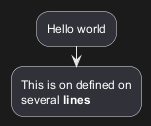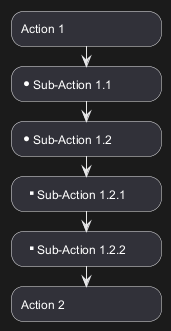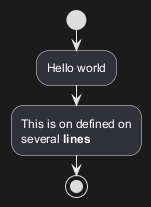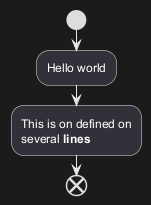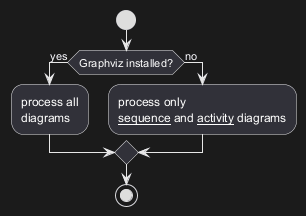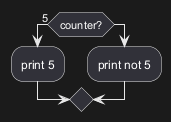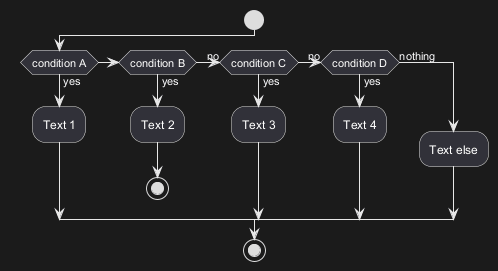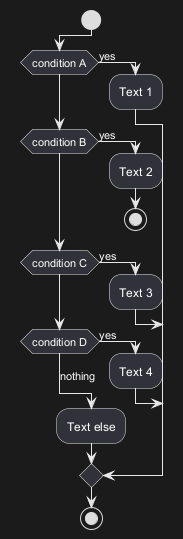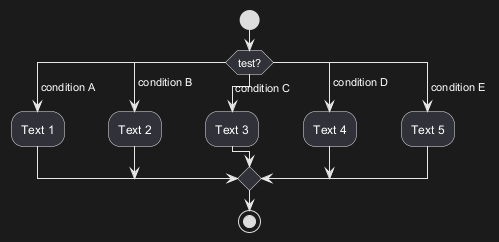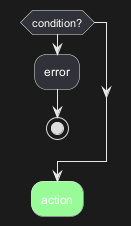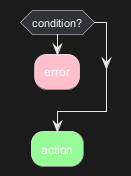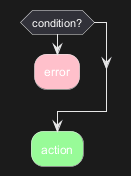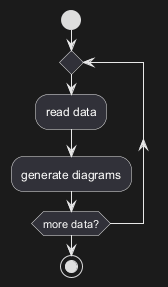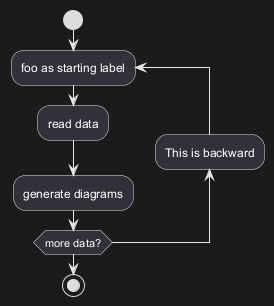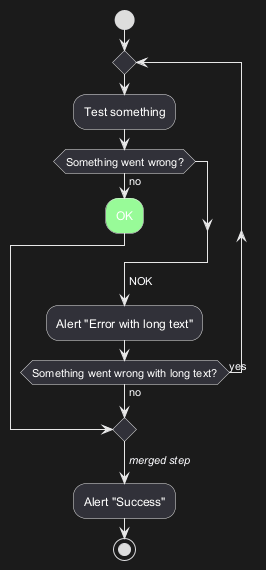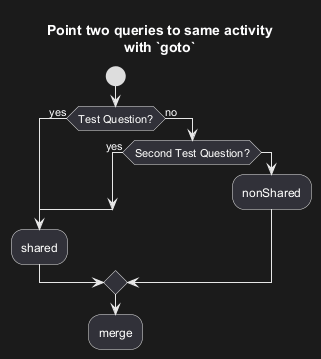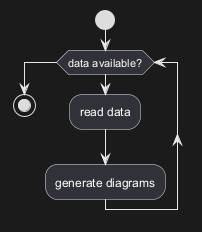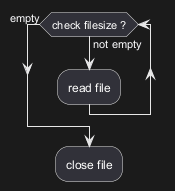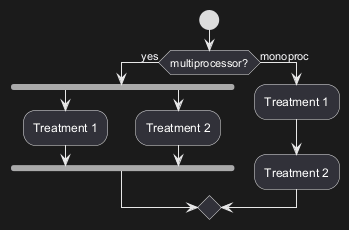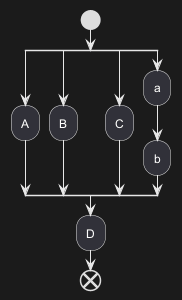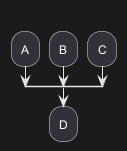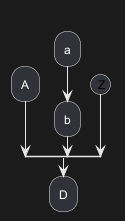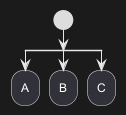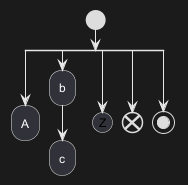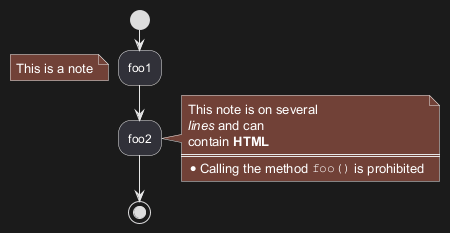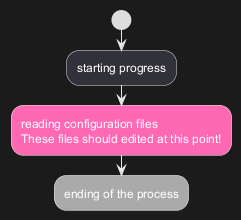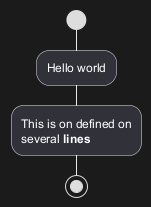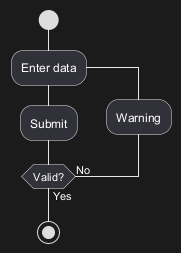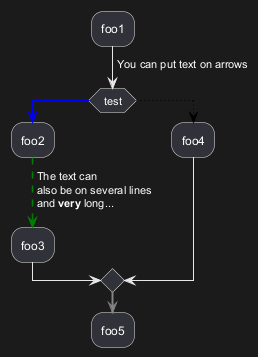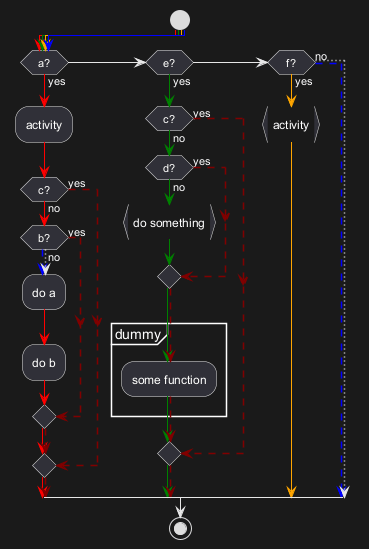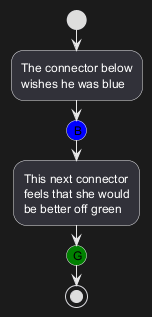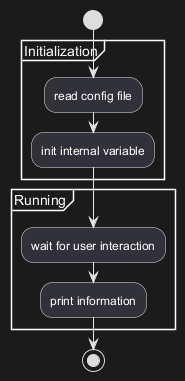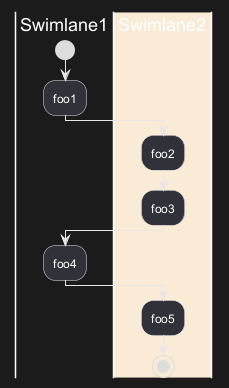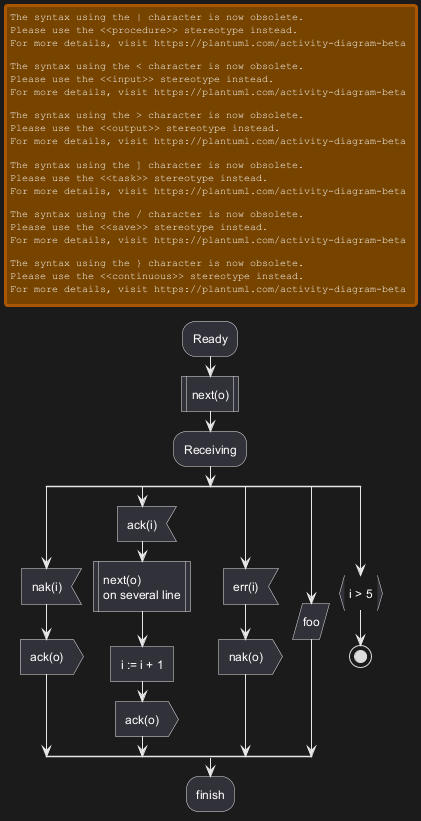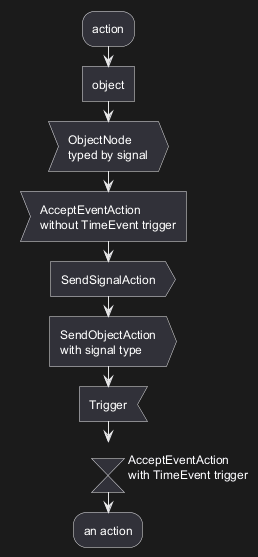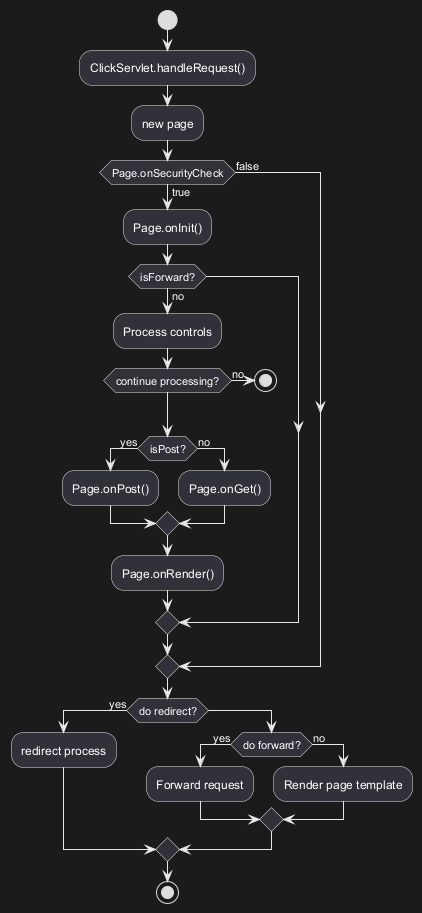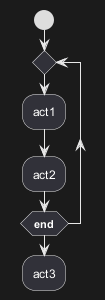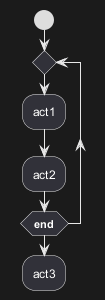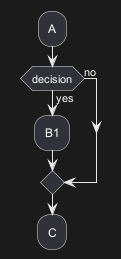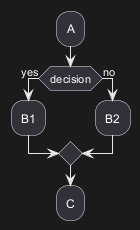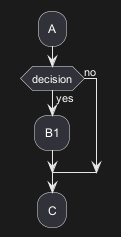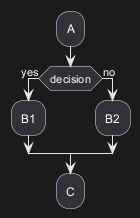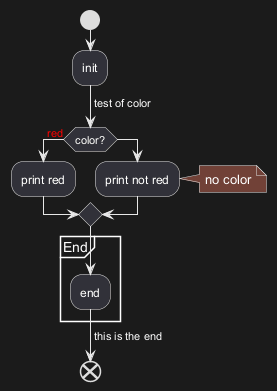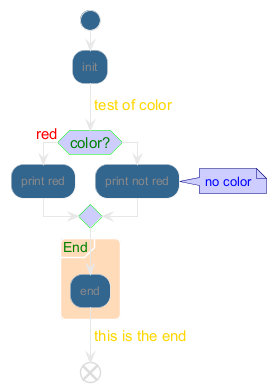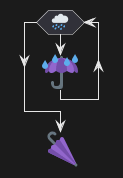Die
bisherige Syntax für Aktivitätsdiagramme wies einige Einschränkungen und Probleme bei der Wartbarkeit auf. Da wir diese Nachteile erkannt haben, haben wir eine komplett überarbeitete Syntax und Implementierung eingeführt, die nicht nur benutzerfreundlich, sondern auch stabiler ist.
Vorteile der neuen Syntax
- Keine Abhängigkeit von Graphviz: Genau wie bei den Sequenzdiagrammen entfällt bei der neuen Syntax die Notwendigkeit einer Graphviz-Installation, wodurch der Einrichtungsprozess vereinfacht wird.
- Einfache Wartung: Die intuitive Natur der neuen Syntax bedeutet, dass es einfacher ist, Ihre Diagramme zu verwalten und zu pflegen.
Umstellung auf die neue Syntax
Während wir die alte Syntax weiterhin unterstützen, um die Kompatibilität aufrechtzuerhalten, ermutigen wir die Benutzer, auf die neue Syntax zu migrieren, um die verbesserten Funktionen und Vorteile, die sie bietet, zu nutzen.
Stellen Sie noch heute um und erleben Sie einen rationalisierten und effizienten Diagrammprozess mit der neuen Aktivitätsdiagramm-Syntax.
Aktivitäts-Labels beginnen mit
: und enden mit
;.
Textformatierungen können mit
Creole Wiki Syntax erfolgen.
Sie sind in ihrer Festlegungsreihenfolge indirekt verbunden.
|
🎉 Copied!


|
@startuml
:Hello world;
:This is on defined on
several **lines**;
@enduml
|
Simple action list separated by -
|
🎉 Copied!


|
@startuml
- Action 1
- Action 2
- Action 3
@enduml
|
Simple action list separated by *
With one level
|
🎉 Copied!


|
@startuml
* Action 1
* Action 2
* Action 3
@enduml
|
With several levels
|
🎉 Copied!


|
@startuml
<style>
element {MinimumWidth 150}
</style>
* Action 1
** Sub-Action 1.1
** Sub-Action 1.2
*** Sub-Action 1.2.1
*** Sub-Action 1.2.2
* Action 2
@enduml
|
[Ref. GH-2376]
Man kann die
start und
stop Schlüsselwörter verwenden um Beginn und Ende des Diagramms zu kennzeichnen.
|
🎉 Copied!


|
@startuml
start
:Hello world;
:This is on defined on
several **lines**;
stop
@enduml
|
Das Schlüsselwort
end beendet ebenfalls das Diagramm, zeigt aber als Symbol den durchkreuzten Kreis.
|
🎉 Copied!


|
@startuml
start
:Hello world;
:This is on defined on
several **lines**;
end
@enduml
|
Sie können die Schlüsselwörter
if,
then,
else und
endif verwenden, um Tests in Ihr Diagramm einzufügen.
Beschriftungen können in Klammern gesetzt werden.
Die 3 Syntaxen sind möglich:
if (...) then (...) ... [else (...) ...] endif
|
🎉 Copied!


|
@startuml
start
if (Graphviz installed?) then (yes)
:process all\ndiagrams;
else (no)
:process only
__sequence__ and __activity__ diagrams;
endif
stop
@enduml
|
if (...) is (...) then ... [else (...) ...] endif
|
🎉 Copied!


|
@startuml
if (color?) is (<color:red>red) then
:print red;
else
:print not red;
endif
@enduml
|
if (...) equals (...) then ... [else (...) ...] endif
|
🎉 Copied!


|
@startuml
if (counter?) equals (5) then
:print 5;
else
:print not 5;
endif
@enduml
|
[Ref. QA-301]
Mehrere Tests (horizontaler Modus)
Sie können das Schlüsselwort
elseif verwenden, um mehrere Tests durchzuführen
(standardmäßig im horizontalen Modus):
|
🎉 Copied!


|
@startuml
start
if (condition A) then (yes)
:Text 1;
elseif (condition B) then (yes)
:Text 2;
stop
(no) elseif (condition C) then (yes)
:Text 3;
(no) elseif (condition D) then (yes)
:Text 4;
else (nothing)
:Text else;
endif
stop
@enduml
|
Mehrere Tests (vertikaler Modus)
Sie können den Befehl
!pragma useVerticalIf on verwenden, um die Tests im vertikalen Modus durchzuführen:
|
🎉 Copied!


|
@startuml
!pragma useVerticalIf on
start
if (condition A) then (yes)
:Text 1;
elseif (condition B) then (yes)
:Text 2;
stop
elseif (condition C) then (yes)
:Text 3;
elseif (condition D) then (yes)
:Text 4;
else (nothing)
:Text else;
endif
stop
@enduml
|
Sie können die
Befehlszeilenoption -P verwenden, um das Pragma anzugeben:
java -jar plantuml.jar -PuseVerticalIf=on
[Refs. QA-3931, GH-582]
WARNING
This translation need to be updated. WARNING
You can use
switch,
case and
endswitch keywords to put switch in your diagram.
Labels can be provided using parentheses.
|
🎉 Copied!


|
@startuml
start
switch (test?)
case ( condition A )
:Text 1;
case ( condition B )
:Text 2;
case ( condition C )
:Text 3;
case ( condition D )
:Text 4;
case ( condition E )
:Text 5;
endswitch
stop
@enduml
|
You can stop action on a if loop.
|
🎉 Copied!


|
@startuml
if (condition?) then
:error;
stop
endif
#palegreen:action;
@enduml
|
But if you want to stop at the precise action, you can use the
kill or
detach keyword:
|
🎉 Copied!


|
@startuml
if (condition?) then
#pink:error;
kill
endif
#palegreen:action;
@enduml
|
[Ref. QA-265]
|
🎉 Copied!


|
@startuml
if (condition?) then
#pink:error;
detach
endif
#palegreen:action;
@enduml
|
Mit den
repeat und
repeatwhile Schlüsselwörtern können Repeat-Schleifen dargestellt werden.
|
🎉 Copied!


|
@startuml
start
repeat
:read data;
:generate diagrams;
repeat while (more data?)
stop
@enduml
|
Es ist desweiteren möglich
repeat an einer Aktion zu nutzen und am Rückpfad mittels des keywords
backward eine weitere Aktion zu spezifizieren. Weiterhin kann auch auf eine andere Aktion verwiesen werden.
|
🎉 Copied!


|
@startuml
start
repeat :foo as starting label;
:read data;
:generate diagrams;
backward:This is backward;
repeat while (more data?)
stop
@enduml
|
*[Ref.
QA-5826]*
WARNING
This translation need to be updated. WARNING
You can use the
break keyword after an action on a loop.
|
🎉 Copied!


|
@startuml
start
repeat
:Test something;
if (Something went wrong?) then (no)
#palegreen:OK;
break
endif
->NOK;
:Alert "Error with long text";
repeat while (Something went wrong with long text?) is (yes) not (no)
->//merged step//;
:Alert "Success";
stop
@enduml
|
[Ref. QA-6105]
⚠ It is currently only experimental 🚧
You can use
label and
goto keywords to denote goto processing, with:
label <label_name>goto <label_name>
|
🎉 Copied!


|
@startuml
title Point two queries to same activity\nwith `goto`
start
if (Test Question?) then (yes)
'space label only for alignment
label sp_lab0
label sp_lab1
'real label
label lab
:shared;
else (no)
if (Second Test Question?) then (yes)
label sp_lab2
goto sp_lab1
else
:nonShared;
endif
endif
:merge;
@enduml
|
[Ref. QA-15026, QA-12526 and initially QA-1626]
Mit den
while und
end while Schlüsselwörtern können While-Schleifen dargestellt werden.
|
🎉 Copied!


|
@startuml
start
while (data available?)
:read data;
:generate diagrams;
endwhile
stop
@enduml
|
Es ist möglich eine Beschriftung hinter dem
endwhile Schlüsselwort anzugeben. Eine Beschriftung kann aber auch mit dem
is Schlüsselwort hinzugefügt werden..
|
🎉 Copied!


|
@startuml
while (check filesize ?) is (not empty)
:read file;
endwhile (empty)
:close file;
@enduml
|
WARNING
This translation need to be updated. WARNING
Mit dem
fork,
fork again und
end fork Schlüsselworten kann eine parallele Verarbeitung angezeigt werden.
|
🎉 Copied!


|
@startuml
start
if (multiprocessor?) then (yes)
fork
:Treatment 1;
fork again
:Treatment 2;
end fork
else (monoproc)
:Treatment 1;
:Treatment 2;
endif
@enduml
|
WARNING
This translation need to be updated. WARNING
Split
You can use
split,
split again and
end split keywords to denote split processing.
|
🎉 Copied!


|
@startuml
start
split
:A;
split again
:B;
split again
:C;
split again
:a;
:b;
end split
:D;
end
@enduml
|
Input split (multi-start)
You can use
hidden arrows to make an input split (multi-start):
|
🎉 Copied!


|
@startuml
split
-[hidden]->
:A;
split again
-[hidden]->
:B;
split again
-[hidden]->
:C;
end split
:D;
@enduml
|
|
🎉 Copied!


|
@startuml
split
-[hidden]->
:A;
split again
-[hidden]->
:a;
:b;
split again
-[hidden]->
(Z)
end split
:D;
@enduml
|
[Ref. QA-8662]
Output split (multi-end)
You can use
kill or
detach to make an output split (multi-end):
|
🎉 Copied!


|
@startuml
start
split
:A;
kill
split again
:B;
detach
split again
:C;
kill
end split
@enduml
|
|
🎉 Copied!


|
@startuml
start
split
:A;
kill
split again
:b;
:c;
detach
split again
(Z)
detach
split again
end
split again
stop
end split
@enduml
|
Textformatierung kann mit
Creole Wiki Syntax gemacht werden.
Eine Anmerkung kann auch schweben, indem das Schlüsselwort
floating benutzt wird.
|
🎉 Copied!


|
@startuml
start
:foo1;
floating note left: This is a note
:foo2;
note right
This note is on several
//lines// and can
contain <b>HTML</b>
====
* Calling the method ""foo()"" is prohibited
end note
stop
@enduml
|
*[Ref. [QA-2398](https://forum.plantuml.net/2398/is-it-possible-to-add-a-comment-on-top-of-a-activity-partition?show=2403#a2403)]*
WARNING
This translation need to be updated. WARNING
Man kann spezielle
Farben für gewisse Aktivitäten verwenden
|
🎉 Copied!


|
@startuml
start
:starting progress;
#HotPink:reading configuration files
These files should edited at this point!;
#AAAAAA:ending of the process;
@enduml
|
*[Ref. [QA-4906](https://forum.plantuml.net/4906/setting-ad-hoc-gradient-backgrounds-in-activity?show=4917#a4917)]*
WARNING
This translation need to be updated. WARNING
You can use
skinparam ArrowHeadColor none in order to connect activities using lines only, without arrows.
|
🎉 Copied!


|
@startuml
skinparam ArrowHeadColor none
start
:Hello world;
:This is on defined on
several **lines**;
stop
@enduml
|
|
🎉 Copied!


|
@startuml
skinparam ArrowHeadColor none
start
repeat :Enter data;
:Submit;
backward :Warning;
repeat while (Valid?) is (No) not (Yes)
stop
@enduml
|
Über die
-> Notation, können Texte an den Pfeilen angezeigt werden und die
Farbe der Pfeile geändert werden.
Es sind auch gepunktete, gestrichelte, dicke oder unsichtbare Pfeile möglich.
|
🎉 Copied!


|
@startuml
:foo1;
-> You can put text on arrows;
if (test) then
-[#blue]->
:foo2;
-[#green,dashed]-> The text can
also be on several lines
and **very** long...;
:foo3;
else
-[#black,dotted]->
:foo4;
endif
-[#gray,bold]->
:foo5;
@enduml
|
You can use multiple colored arrow.
|
🎉 Copied!


|
@startuml
skinparam colorArrowSeparationSpace 1
start
-[#red;#green;#orange;#blue]->
if(a?)then(yes)
-[#red]->
:activity;
-[#red]->
if(c?)then(yes)
-[#maroon,dashed]->
else(no)
-[#red]->
if(b?)then(yes)
-[#maroon,dashed]->
else(no)
-[#blue,dashed;dotted]->
:do a;
-[#red]->
:do b;
-[#red]->
endif
-[#red;#maroon,dashed]->
endif
-[#red;#maroon,dashed]->
elseif(e?)then(yes)
-[#green]->
if(c?)then(yes)
-[#maroon,dashed]->
else(no)
-[#green]->
if(d?)then(yes)
-[#maroon,dashed]->
else(no)
-[#green]->
:do something; <<continuous>>
-[#green]->
endif
-[#green;#maroon,dashed]->
partition dummy {
:some function;
}
-[#green;#maroon,dashed]->
endif
-[#green;#maroon,dashed]->
elseif(f?)then(yes)
-[#orange]->
:activity; <<continuous>>
-[#orange]->
else(no)
-[#blue,dashed;dotted]->
endif
stop
@enduml
|
[Ref. QA-4411]
You can use parentheses to denote connector.
|
🎉 Copied!


|
@startuml
start
:Some activity;
(A)
detach
(A)
:Other activity;
@enduml
|
You can add
color on connector.
|
🎉 Copied!


|
@startuml
start
:The connector below
wishes he was blue;
#blue:(B)
:This next connector
feels that she would
be better off green;
#green:(G)
stop
@enduml
|
[Ref. QA-10077]
And even use style on Circle:
|
🎉 Copied!


|
@startuml
<style>
circle {
Backgroundcolor palegreen
LineColor green
LineThickness 2
}
</style>
(1)
:a;
(A)
@enduml
|
[Ref. QA-19975]
Aktivitäten können durch Partitionen gruppiert werden:
|
🎉 Copied!


|
@startuml
start
partition Initialization {
:read config file;
:init internal variable;
}
partition Running {
:wait for user interaction;
:print information;
}
stop
@enduml
|
*[Ref. [QA-2793](https://forum.plantuml.net/2793/activity-beta-partition-name-more-than-one-word-does-not-work?show=2798#a2798)]*
*[Ref. [QA-542](https://forum.plantuml.net/542/ability-to-define-hyperlink-on-diagram-elements?show=14003#c14003)]*
WARNING
This translation need to be updated. WARNING
Mit dem Pipe Zeichen
| kann man Schwimmbahnen definieren.
Es ist auch möglich die
Schwimmbahnfarbe zu ändern.
|
🎉 Copied!


|
@startuml
|Swimlane1|
start
:foo1;
|#AntiqueWhite|Swimlane2|
:foo2;
:foo3;
|Swimlane1|
:foo4;
|Swimlane2|
:foo5;
stop
@enduml
|
*[Ref. [QA-2681](https://forum.plantuml.net/2681/possible-define-alias-swimlane-place-alias-everywhere-else?show=2685#a2685)]*
WARNING
This translation need to be updated. WARNING
Es ist möglich mit dem
detach Schlüsselwort einen Pfeil zu entfernen.
|
🎉 Copied!


|
@startuml
:start;
fork
:foo1;
:foo2;
fork again
:foo3;
detach
endfork
if (foo4) then
:foo5;
detach
endif
:foo6;
detach
:foo7;
stop
@enduml
|
Durch Ändern des letzten Separators
; können Sie unterschiedliche Wiedergabe für die Aktivität einstellen:
|
🎉 Copied!


|
@startuml
:Ready;
:next(o)|
:Receiving;
split
:nak(i)<
:ack(o)>
split again
:ack(i)<
:next(o)
on several line|
:i := i + 1]
:ack(o)>
split again
:err(i)<
:nak(o)>
split again
:foo/
split again
:i > 5}
stop
end split
:finish;
@enduml
|
WARNING
This translation need to be updated. WARNING
Table of UML Shape Name
|
Name
|
Stereotype syntax
|
|
ObjectNode
|
<<object>>
|
ObjectNode
typed by signal
|
<<objectSignal>> or <<object-signal>>
|
AcceptEventAction
without TimeEvent trigger
|
<<acceptEvent>> or <<accept-event>>
|
AcceptEventAction
with TimeEvent trigger
|
<<timeEvent>> or <<time-event>>
|
SendSignalAction
SendObjectAction
with signal type
|
<<sendSignal>> or <<send-signal>>
|
|
Trigger
|
<<trigger>>
|
[Ref. GH-2185]
UML Shape Example using Stereotype
|
🎉 Copied!


|
@startuml
:action;
:object; <<object>>
:ObjectNode
typed by signal; <<objectSignal>>
:AcceptEventAction
without TimeEvent trigger; <<acceptEvent>>
:SendSignalAction; <<sendSignal>>
:SendObjectAction
with signal type; <<sendSignal>>
:Trigger; <<trigger>>
:\t\t\t\t\t\tAcceptEventAction
\t\t\t\t\t\twith TimeEvent trigger; <<timeEvent>>
:an action;
@enduml
|
[Ref. GH-2185, QA-16558, GH-1659]
|
🎉 Copied!


|
@startuml
start
:ClickServlet.handleRequest();
:new page;
if (Page.onSecurityCheck) then (true)
:Page.onInit();
if (isForward?) then (no)
:Process controls;
if (continue processing?) then (no)
stop
endif
if (isPost?) then (yes)
:Page.onPost();
else (no)
:Page.onGet();
endif
:Page.onRender();
endif
else (false)
endif
if (do redirect?) then (yes)
:redirect process;
else
if (do forward?) then (yes)
:Forward request;
else (no)
:Render page template;
endif
endif
stop
@enduml
|
Inside style (by default)
|
🎉 Copied!


|
@startuml
skinparam conditionStyle inside
start
repeat
:act1;
:act2;
repeatwhile (<b>end)
:act3;
@enduml
|
|
🎉 Copied!


|
@startuml
start
repeat
:act1;
:act2;
repeatwhile (<b>end)
:act3;
@enduml
|
Diamond style
|
🎉 Copied!


|
@startuml
skinparam conditionStyle diamond
start
repeat
:act1;
:act2;
repeatwhile (<b>end)
:act3;
@enduml
|
InsideDiamond (or Foo1) style
|
🎉 Copied!


|
@startuml
skinparam conditionStyle InsideDiamond
start
repeat
:act1;
:act2;
repeatwhile (<b>end)
:act3;
@enduml
|
|
🎉 Copied!


|
@startuml
skinparam conditionStyle foo1
start
repeat
:act1;
:act2;
repeatwhile (<b>end)
:act3;
@enduml
|
[Ref. QA-1290 and #400]
Diamond style (by default)
|
🎉 Copied!


|
@startuml
skinparam ConditionEndStyle diamond
:A;
if (decision) then (yes)
:B1;
else (no)
endif
:C;
@enduml
|
- With two branches (
B1, B2)
|
🎉 Copied!


|
@startuml
skinparam ConditionEndStyle diamond
:A;
if (decision) then (yes)
:B1;
else (no)
:B2;
endif
:C;
@enduml
@enduml
|
Horizontal line (hline) style
|
🎉 Copied!


|
@startuml
skinparam ConditionEndStyle hline
:A;
if (decision) then (yes)
:B1;
else (no)
endif
:C;
@enduml
|
- With two branches (
B1, B2)
|
🎉 Copied!


|
@startuml
skinparam ConditionEndStyle hline
:A;
if (decision) then (yes)
:B1;
else (no)
:B2;
endif
:C;
@enduml
@enduml
|
[Ref. QA-4015]
Without style (by default)
|
🎉 Copied!


|
@startuml
start
:init;
-> test of color;
if (color?) is (<color:red>red) then
:print red;
else
:print not red;
note right: no color
endif
partition End {
:end;
}
-> this is the end;
end
@enduml
|
With style
You can use
style to change rendering of elements.
|
🎉 Copied!


|
@startuml
<style>
activityDiagram {
BackgroundColor #33668E
BorderColor #33668E
FontColor #888
FontName arial
diamond {
BackgroundColor #ccf
LineColor #00FF00
FontColor green
FontName arial
FontSize 15
}
arrow {
FontColor gold
FontName arial
FontSize 15
}
partition {
LineColor red
FontColor green
RoundCorner 10
BackgroundColor PeachPuff
}
note {
FontColor Blue
LineColor Navy
BackgroundColor #ccf
}
}
document {
BackgroundColor transparent
}
</style>
start
:init;
-> test of color;
if (color?) is (<color:red>red) then
:print red;
else
:print not red;
note right: no color
endif
partition End {
:end;
}
-> this is the end;
end
@enduml
|
You can use
emoji as action, with the stereotype
<<icon>>:
|
🎉 Copied!


|
@startuml
while (<:cloud_with_rain:>)
:<:umbrella:>; <<icon>>
endwhile
-<<icon>><:closed_umbrella:>
@enduml
|
[Ref. GH-2436]
